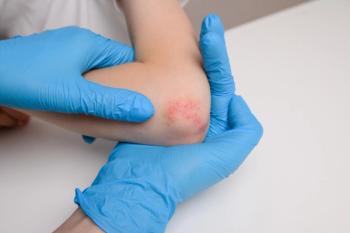
AAD Guidelines Evaluate Links Between Atopic Dermatitis, Comorbidities
The American Academy of Dermatology’s newest guideline focuses on awareness of other health conditions associated with atopic dermatitis in adult patients.
The American Academy of Dermatology (AAD) has released new guidelines on atopic dermatitis (AD) and its comorbidities.1 The AAD dives into the evidence supporting these comorbidities—which include subjects like bone health and cardiovascular diseases—as the first part of a 4-part series and has discovered possible stronger evidence to support some associations. A multidisciplinary work group was created to evaluate evidence and determine the association between AD and these other conditions.
In its systematic review, the work group used the Grading of Recommendations, Assessment, Development, and Evaluation (GRADE) to weigh the certainty of evidence for AD and a range of comorbid conditions.2-5 Based on the strength and quality of evidence, the work group released statements on the various associations.
Atopic and Allergic Conditions
The meta-analysis found that 24.8% of adult patients with AD have asthma (95% CI, 223, 22.2%-27.5%) but with substantial heterogeneity across studies. Also, those with AD are 3 times as likely to have asthma compared with the general population. There appears to be a stronger association between severe AD and asthma than mild or moderate cases.
Results of a cross-sectional population-based survey that defined AD by Patient Oriented Eczema Measure scores found that patients with severe AD had a relative risk (RR) of 2.38 (95% CI, 1.91-2.85) for asthma compared with the participants without AD, with small risk seen with moderate AD (RR, 1.94; 95% CI, 1.66-2.21) and mild AD (RR, 1.34; 95% CI, 1.12-1.56).6
The work group determined that atopic march theory of epidermal barrier disruption associated with AD will lead to skin allergy sensitivity and inflammation. However, an immune response at other epithelial surfaces like the gastrointestinal tract (food allergy), upper respiratory tract (allergic rhinitis), and lower respiratory tract (asthma) was unproven.7 Longitudinal studies have shown that patients with multiple atopic morbidities usually do not have AD before developing other atopic conditions, which may suggest that other factors need to be investigated beyond barrier disruption.8,9
Turning to pediatric cases, the work group found that evidence showed that patients with asthma between ages 7 and 13 were also associated with a more persistent AD phenotype.10 The work group suggested that this knowledge may help when counseling pediatric patients about managing AD into their adulthood. Also, targeted therapies, like dupilumab (Dupixent; Sanofi and Regeneron), were found to improve outcomes of both severe AD and asthma.11,12
The statements are:
Findings regarding atopic dermatitis (AD) in adults included the following:
- AD is associated with asthma (moderate-quality evidence).
- Greater AD severity is associated with increasing asthma prevalence (moderate-quality evidence).
Next, the work group looked at food allergies, which already had a highly suggested association with AD, and got a better picture of the relationship. They found “clear evidence” of a link in adult patients, but the prevalence of food allergies among the AD patient population (11%; 95% CI, 6%-16%) is limited by heterogeneity across studies.1 The heterogeneity was related to the definition of the food allergy, the type of food, and the use of self-report, physician diagnosis, or administrative codes.
There may be a relationship between the severity of AD and IgE-mediated food allergy, with the odds of having a food allergy compared with the general population increasing from mild (RR, 1.48; 95% CI, 0.89-2.07) to moderate (RR, 2.40; 95% CI, 1.54-3.27) to severe (RR, 8.49; 95% CI, 5.44-11.54) AD.6 The clinical implications of the association between AD and food allergies are unclear, the work group continued.
The statements are:
- AD in adults is associated with food allergies (high-quality evidence).
- Greater AD severity is associated with increasing food allergy prevalence (moderate-quality evidence).
Addressing allergic rhinitis, conjunctivitis, and eosinophilic esophagitis, the work group acknowledged that although AD is not studied as much as asthma regarding its association with allergic rhinitis, it is still recognized as a common comorbidity of AD and is a component of some diagnostic criteria for AD.13,14
“In studies comparing the prevalence or incidence of allergic rhinitis between AD and the general population or general clinic population controls, AD was consistently associated with allergic rhinitis, but the magnitude of the association varied widely across different study designs and populations,” the work group wrote.
Little evidence supports the associations between AD and allergic conjunctivitis and eosinophilic esophagitis, according to the work group.
The statements are:
- AD in adults is associated with allergic rhinitis (moderate-quality evidence).
- The association between AD in adults and allergic conjunctivitis is uncertain (low-quality evidence).
- AD in adults may be associated with eosinophilic esophagitis (low-quality evidence).
Immune-Mediated Conditions
Investigators of many epidemiologic studies identified an association between AD and alopecia areata (AA).15 Findings from a Danish study showed that the adjusted odds ratio (OR) for the association between AD and AA was 26.31 (95% CI, 14.48-47.70).16 Some of the strength may be because of diagnostic bias, but the work group still found it to be valid. They also addressed the contention that AD is related to a worse prognosis of AA severity and response to treatment, but related studies are limited. Results of an AA registry study did show that AD is associated with a higher likelihood of having alopecia totalis or universalis, but the finding was not statistically significant (OR, 1.24; 95% CI, 0.95-1.61).17
There are no targeted systemic treatments approved for AA. Dupilumab may be a potentialoption but was also reported to cause new-onset alopecia areata.18 Additionally, Janus kinase inhibitors show promise for both AD and AA but are not yet approved in the United States for either indication.19
The statement is:
- AD in adults is associated with alopecia areata (moderate-quality evidence).
Urticaria was also reviewed. In a study on autoimmune conditions, investigators from Denmark demonstrated a strong association between chronic urticaria and AD (OR, 9.92; 95% CI, 6.43-15.32).16 Findings from another study showed that patients with chronic urticaria were more likely to receive a diagnosis of AD (HR, 3.1; 95% CI, 2.0-4.8).20
In a clinical setting, itch is a common complaint among patients with either condition, and scratching can worsen the dermatitis. In study findings, omalizumab (Xolair; Genentech), an anti-IgE monoclonal antibody, has been shown to treat chronic idiopathic urticaria effectively in adults. However, it had mixed results when studied in randomized controlled trials in pediatric AD.21,22
The statement is:
- AD in adults is associated with urticaria (moderate-quality evidence).
Cardiovascular Diseases
There is an established risk between systemic inflammation and cardiovascular disease, and targeting inflammation reduces the risk of cardiovascular events.23 That connection prompted research into a potential link between AD and cardiovascular disease. Vascular inflammation and markers of atherosclerosis were shown to correlate with markers of helper T-cell 2 inflammation in the skin and blood of patients with AD, and patients with AD have increased levels of proteins associated with cardiovascular risk, the work group explained.24, 25
There may be a slight association between AD and hypertension, peripheral and coronary artery disease, congestive heart failure, and acute events such as myocardial infarction and cardiovascular death. The work group stated that, in general, these associations as strong as those for AD and psoriasis, so they added qualifying remarks to those statements. In the meta-analysis of the occurrence of hypertension in adults with AD compared with controls, the OR was 1.06 (95% CI, 1.00-1.13).1 When pooling cohort studies for the association between AD and congestive heart failure, the HR was 1.25 (95% CI, 1.03-1.53).1
In an epidemiologic cohort study from the UK, AD severity gradients were seen for:26
- Myocardial infarction (mild AD: HR, 1.00; 95% CI, 0.91-1.10; moderate: HR, 1.07; 95% CI, 0.97-1.18; severe: HR, 1.37; 95% CI, 1.12-1.68);
- stroke (mild AD: HR, 1.06; 95% CI, 0.97-1.15; moderate: HR, 1.09; 95% CI, 1.00-1.20; severe: HR, 1.20; 95% CI, 0.99-1.46);
- congestive heart failure (mild AD: HR,1.12; 95% CI, 1.02-1.24; moderate: HR, 1.20; 95% CI, 1.09-1.33; severe: HR, 1.67; 95% CI, 1.36-2.05); and
- cardiovascular death (mild AD: HR, 0.90; 95% CI, 0.89-0.98; moderate: HR, 1.01; 95% CI, 0.93-1.10; severe: HR, 1.30; 95% CI, 1.10-1.53).
It should be noted treatment is frequently used as a proxy to define AD severity in epidemiologic studies, like the one above.
The work group wrote that the clinical implications of these associations are unclear, and current trials in AD did not demonstrate an increased risk of venous thromboembolism.27-33
The statements are:
- AD in adults is probably associated with hypertension (moderate-quality evidence).*Remark: The evidence suggests a small magnitude of association between AD and hypertension in adults.
- AD in adults is probably associated with coronary artery disease (moderate-quality evidence). *Remark: The evidence suggests a small magnitude of association between AD and coronary artery disease in adults.
- AD in adults is probably associated with peripheral artery disease (moderate quality evidence). * Remark: The evidence suggests a small to moderate magnitude of association between AD and peripheral artery disease in adults, with greater AD severity associated with a greater magnitude of association.
- The association between AD in adults and myocardial infarction is uncertain (low-quality evidence).
- Severe AD in adults may be associated with myocardial infarction (low-quality evidence).
- The association between AD in adults and stroke is uncertain (very-low-quality evidence).
- AD in adults is probably associated with congestive heart failure (moderate-quality evidence). * Remark: The evidence suggests a small to moderate magnitude of association between AD and congestive heart failure in adults, with greater AD severity associated with a greater magnitude of association.
- AD in adults is probably associated with thromboembolic diseases (moderate-quality evidence). * Remark: The evidence suggests a small magnitude of association between AD and thromboembolic diseases in adults.
- AD in adults may be associated with cardiovascular death (low-quality evidence). *Remark: The evidence suggests a small magnitude of association between AD and cardiovascular death in adults.
Metabolic Disorders
Current evidence suggests a small association between adult AD and obesity and dyslipidemia. Data from 8 cross-sectional studies that the work group pooled showed that AD was or is associated with 36% increased odds of obesity (OR, 1.36; 95% CI, 1.01-1.83) and 13% increased odds of hypercholesterolemia (OR, 1.13; 95% CI, 1.09-1.18) compared with the general population.1 As this point, it is unclear if the AD severity affects the association of obesity.34,35 The association may vary geography.36
AD may have an inverse association with diabetes. The work group found that AD was associated with a lower risk of diabetes overall (OR, 0.89; 95% CI, 0.80-0.99) and type 2 diabetes specifically (OR, 0.83; 95% CI, 0.76-0.90).1 Only 2 studies compared metabolic syndrome as a whole in individuals with and without AD.37,38
The statements are:
- AD in adults is probably associated with obesity (moderate-quality evidence).
- AD in adults is probably associated with dyslipidemia (moderate-quality evidence).
- AD in adults may not be associated with diabetes (low-quality evidence).
- The association between AD in adults and metabolic syndrome is uncertain (very-low-quality evidence)
Bone Health
Taiwanese investigators reported that AD was associated with an increased risk of developing osteoporosis (HR, 4.72; 95% CI, 3.68-6.05).39 Also, findings of a UK cohort study showed that the risk of fracture associated with AD was modestly increased overall (HR, 1.07; 99% CI, 1.05-1.09) and slightly higher for those with severe AD (HR, 1.22; 99% CI, 1.14-1.30).40 Additionally, the risk was much higher for fractures related to osteoporosis, with severe AD associated with 200%, 66%, and 50% increased rates of spinal, pelvic, and hip fractures, respectively.40
Although investigators have offered various potential explanations for the association between AD, osteoporosis, and fractures, further research is needed to determine the true mechanism, according to the work group. Some explanations suggest that chronic systemic inflammation leads to aberrant bone metabolism and increased bone loss.41-43 Also, on average, patients with AD are more likely to be deficient in vitamin D, and sleep disruptions caused by AD may lead to increased risk of injury in general.44,45 Oral corticosteroids can heighten the risk of fractures, possibly affecting patients with AD who are being treated with those agents.46-48 The evidence of topical corticosteroid use and its relation to risk of fractures is being studied but remains unclear.49
The statments are:
- AD in adults is associated with osteoporosis (high-quality evidence).
- AD in adults is associated with bone fractures (moderate-quality evidence).
Skin Infection
The association between AD and staphylococcal skin infection is well established.50 Herpes superinfection (herpes simplex virus [HSV] or eczema herpeticum) is a more severe complication of AD,51 and results of a UK cohort study showed HSV infections to be more than twice as common among people with AD compared with the general population, the work group explained.52
AD is also associated with serious cutaneous infections (defined as those that lead to hospitalization, are life-threatening, or require treatment in an inpatient setting), according to data from hospitals across the United States (OR, 4.62; 95% CI, 4.51-4.74).1 It was also found that bacterial skin infections and HSV are more likely to occur with poorly controlled dermatitis; successful treatment may reduce the incidence of these infections.53
The statement is:
- AD in adults is associated with skin infection (moderate-quality evidence).
Refereces
1. Davis DMR, Drucker AM, Alikhan A, et al. AAD Guidelines: awareness of comorbidities associated with atopic dermatitis in adults. Journal of the American Academy of Dermatology. Published online January 2022:S0190962222000809. doi: 10.1016/j.jaad.2022.01.009.
2. Andrews J, Guyatt G, Oxman AD, et al. GRADE guidelines: 14. Going from evidence to recommendations: the significance and presentation of recommendations. J Clin Epidemiol. 2013;66(7):719-725. doi: 10.1016/j.jclinepi.2012.03.013.
3. Andrews JC, Schünemann HJ, Oxman AD, et al. GRADE guidelines: 15. Going from evidence to recommendation—determinants of a recommendation’s direction and strength. J Clin Epidemiol. 2013;66(7):726-735. doi: 10.1016/j.jclinepi.2013.02.003.
4. Balshem H, Helfand M, Schünemann HJ, et al. GRADE guidelines: 3. Rating the quality of evidence. J Clin Epidemiol. 2011;64(4):401-406. doi: 10.1016/j.jclinepi.2010.07.015.
5. Foroutan F, Guyatt G, Zuk V, et al. GRADE Guidelines 28: Use of GRADE for the assessment of evidence about prognostic factors: rating certainty in identification of groups of patients with different absolute risks. J Clin Epidemiol. 2020;121:62-70. doi: 10.1016/j.jclinepi.2019.12.023.
6. Silverberg JI, Gelfand JM, Margolis DJ, et al. Association of atopic dermatitis with allergic, autoimmune, and cardiovascular comorbidities in US adults. Annals of Allergy, Asthma & Immunology. 2018;121(5):604-612.e3. doi: 10.1016/j.anai.2018.07.042.
7. Spergel J. Atopic dermatitis and the atopic march. Journal of Allergy and Clinical Immunology. 2003;112(6):S118-S127. doi: 10.1016/j.jaci.2003.09.033.
8. Martin PE, Matheson MC, Gurrin L, et al. Childhood eczema and rhinitis predict atopic but not nonatopic adult asthma: A prospective cohort study over 4 decades. Journal of Allergy and Clinical Immunology. 2011;127(6):1473-1479.e1. doi: 10.1016/j.jaci.2011.02.041.
9. Gough H, Grabenhenrich L, Reich A, et al. Allergic multimorbidity of asthma, rhinitis and eczema over 20 years in the German birth cohort MAS. Pediatr Allergy Immunol. 2015;26(5):431-437. doi: 10.1111/pai.12410.
10. Paternoster L, Savenije OEM, Heron J, et al. Identification of atopic dermatitis subgroups in children from 2 longitudinal birth cohorts. Journal of Allergy and Clinical Immunology. 2018;141(3):964-971. Doi: 10.1016/j.jaci.2017.09.044.
11. Castro M, Corren J, Pavord ID, et al. Dupilumab efficacy and safety in moderate-to-severe uncontrolled asthma. N Engl J Med. 2018;378(26):2486-2496. Doi: 10.1056/NEJMoa1804092.
12. Simpson EL, Bieber T, Guttman-Yassky E, et al. Two phase 3 trials of dupilumab versus placebo in atopic dermatitis. N Engl J Med. 2016;375(24):2335-2348. Doi: 10.1056/NEJMoa1610020.
13. Hanifin JM, Rajka G. Diagnostic Features of Atopic-Dermatitis. Acta Derm-Venereol 1980:44-7.
14. Williams HC, Jburney PG, Pembroke AC, Hay RJ, Atopic Dermatitis Diagnostic Criteria Working Party. The u. K. Working party’s diagnostic criteria for atopic dermatitis. Iii. Independent hospital validation. Br J Dermatol. 1994;131(3):406-416. Doi: 10.1111/j.1365-2133.1994.tb08532.x.
15. Mohan GC, Silverberg JI. Association of vitiligo and alopecia areata with atopic dermatitis: a systematic review and meta-analysis. JAMA Dermatol. 2015;151(5):522-528. doi:10.1001/jamadermatol.2014.3324
16. Andersen YMF, Egeberg A, Gislason GH, Skov L, Thyssen JP. Autoimmune diseases in adults with atopic dermatitis. J Am Acad Dermatol. 2017;76(2):274-280.e1. doi:10.1016/j.jaad.2016.08.047
17. Barahmani N, Schabath MB, Duvic M, National Alopecia Areata Registry. History of atopy or autoimmunity increases risk of alopecia areata. J Am Acad Dermatol. 2009;61(4):581-591. doi:10.1016/j.jaad.2009.04.031
18. Marks DH, Mesinkovska N, Senna MM. Cause or cure? Review of dupilumab and alopecia areata. J Am Acad Dermatol. Published online June 13, 2019:S0190-9622(19)30973-9. doi:10.1016/j.jaad.2019.06.010
19. Damsky W, King BA. JAK inhibitors in dermatology: The promise of a new drug class. J Am Acad Dermatol. 2017;76(4):736-744. doi:10.1016/j.jaad.2016.12.005
20. Ghazanfar MN, Kibsgaard L, Thomsen SF, Vestergaard C. Risk of comorbidities in patients diagnosed with chronic urticaria: A nationwide registry-study. World Allergy Organ J. 2020;13(1):100097. doi:10.1016/j.waojou.2019.100097
21. Chan S, Cornelius V, Cro S, Harper JI, Lack G. Treatment effect of omalizumab on severe pediatric atopic dermatitis: the adapt randomized clinical trial. JAMA Pediatr. 2020;174(1):29-37. doi:10.1001/jamapediatrics.2019.4476
22. Iyengar SR, Hoyte EG, Loza A, et al. Immunologic effects of omalizumab in children with severe refractory atopic dermatitis: a randomized, placebo-controlled clinical trial. Int Arch Allergy Immunol. 2013;162(1):89-93. doi:10.1159/000350486
23. Ridker PM, Everett BM, Thuren T, et al. Antiinflammatory therapy with canakinumab for atherosclerotic disease. N Engl J Med. 2017;377(12):1119-1131. doi:10.1056/NEJMoa1707914
24. Villani AP, Pavel AB, Wu J, Fernandes M, Maari C, Saint-Cyr Proulx E et al. Vascular inflammation in moderate-to-severe atopic dermatitis is associated with enhanced Th2 response. Allergy 2021. https://innovaderm.com/innovaderm-resources/publications
25. Brunner PM, Suárez-Fariñas M, He H, et al. The atopic dermatitis blood signature is characterized by increases in inflammatory and cardiovascular risk proteins. Sci Rep. 2017;7(1):8707. doi:10.1038/s41598-017-09207-z
26. Silverwood RJ, Forbes HJ, Abuabara K, et al. Severe and predominantly active atopic eczema in adulthood and long term risk of cardiovascular disease: population based cohort study. BMJ. 2018;361:k1786. doi:10.1136/bmj.k1786.
27. Bieber T, Simpson EL, Silverberg JI, et al. Abrocitinib versus placebo or dupilumab for atopic dermatitis. New England Journal of Medicine. 2021;384(12):1101-1112. doi:10.1056/NEJMoa2019380.
28. Gooderham MJ, Forman SB, Bissonnette R, et al. Efficacy and safety of oral janus kinase 1 inhibitor abrocitinib for patients with atopic dermatitis: a phase 2 randomized clinical trial. JAMA Dermatol. 2019;155(12):1371-1379. doi:10.1001/jamadermatol.2019.2855
29. Simpson EL, Sinclair R, Forman S, et al. Efficacy and safety of abrocitinib in adults and adolescents with moderate-to-severe atopic dermatitis (JADE MONO-1): a multicentre, double-blind, randomised, placebo-controlled, phase 3 trial. Lancet. 2020;396(10246):255-266. doi:10.1016/S0140-6736(20)30732-7
30. Guttman-Yassky E, Silverberg JI, Nemoto O, et al. Baricitinib in adult patients with moderate-to-severe atopic dermatitis: A phase 2 parallel, double-blinded, randomized placebo-controlled multiple-dose study. J Am Acad Dermatol. 2019;80(4):913-921.e9. doi:10.1016/j.jaad.2018.01.018
31. Simpson EL, Forman S, Silverberg JI, et al. Baricitinib in patients with moderate-to-severe atopic dermatitis: Results from a randomized monotherapy phase 3 trial in the United States and Canada (Breeze-ad5). J Am Acad Dermatol. 2021;85(1):62-70. doi:10.1016/j.jaad.2021.02.028
32. Simpson EL, Lacour JP, Spelman L, et al. Baricitinib in patients with moderate-to-severe atopic dermatitis and inadequate response to topical corticosteroids: results from two randomized monotherapy phase III trials. Br J Dermatol. 2020;183(2):242-255. doi:10.1111/bjd.18898
33. Guttman-Yassky E, Thaçi D, Pangan AL, et al. Upadacitinib in adults with moderate to severe atopic dermatitis: 16-week results from a randomized, placebo-controlled trial. J Allergy Clin Immunol. 2020;145(3):877-884. doi:10.1016/j.jaci.2019.11.025
34. Sicras-Mainar A, Navarro-Artieda R, Carrascosa Carrillo JM. Economic impact of atopic dermatitis in adults: a population-based study(Idea study). Actas Dermosifiliogr (Engl Ed). 2018;109(1):35-46. doi:10.1016/j.ad.2017.09.003
35. Ascott A, Mansfield KE, Schonmann Y, et al. Atopic eczema and obesity: a population-based study. Br J Dermatol. 2021;184(5):871-879. doi:10.1111/bjd.19597
36. Zhang A, Silverberg JI. Association of atopic dermatitis with being overweight and obese: a systematic review and metaanalysis. J Am Acad Dermatol. 2015;72(4):606-616.e4. doi:10.1016/j.jaad.2014.12.013
37. Shalom G, Dreiher J, Kridin K, et al. Atopic dermatitis and the metabolic syndrome: a cross-sectional study of 116 816 patients. J Eur Acad Dermatol Venereol. 2019;33(9):1762-1767. doi:10.1111/jdv.15642
38. Lee JH, Jung HM, Han KD, et al. Association between metabolic syndrome and atopic dermatitis in korean adults. Acta Derm Venereol. 2017;97(1):77-80. doi:10.2340/00015555-2441
39. Wu CY, Lu YY, Lu CC, Su YF, Tsai TH, Wu CH. Osteoporosis in adult patients with atopic dermatitis: A nationwide population-based study. PLOS ONE. 2017;12(2):e0171667. doi:10.1371/journal.pone.0171667
40. Lowe KE, Mansfield KE, Delmestri A, et al. Atopic eczema and fracture risk in adults: A population-based cohort study. J Allergy Clin Immunol. 2020;145(2):563-571.e8. doi:10.1016/j.jaci.2019.09.015
41. Bonefeld CM, Petersen TH, Bandier J, et al. Epidermal filaggrin deficiency mediates increased systemic T-helper 17 immune response. Br J Dermatol. 2016;175(4):706-712. doi:10.1111/bjd.14570
42. Uluçkan Ö, Jimenez M, Karbach S, et al. Chronic skin inflammation leads to bone loss by IL-17-mediated inhibition of Wnt signaling in osteoblasts. Sci Transl Med. 2016;8(330):330ra37. doi:10.1126/scitranslmed.aad8996
43. Suárez-Fariñas M, Dhingra N, Gittler J, et al. Intrinsic atopic dermatitis (Ad) shows similar Th2 and higher Th17 immune activation compared to extrinsic AD. J Allergy Clin Immunol. 2013;132(2):361-370. doi:10.1016/j.jaci.2013.04.046
44. Oren E, Banerji A, Camargo CA. Vitamin D and atopic disorders in an obese population screened for vitamin D deficiency. J Allergy Clin Immunol. 2008;121(2):533-534. doi:10.1016/j.jaci.2007.11.005
45. Garg NK, Silverberg JI. Eczema is associated with osteoporosis and fractures in adults: a US population-based study. J Allergy Clin Immunol. 2015;135(4):1085-1087.e2. doi:10.1016/j.jaci.2014.10.043
46. Drucker AM, Eyerich K, de Bruin-Weller MS, et al. Use of systemic corticosteroids for atopic dermatitis: International Eczema Council consensus statement. Br J Dermatol. 2018;178(3):768-775. doi:10.1111/bjd.15928
47. Simpson EL, Bieber T, Eckert L, et al. Patient burden of moderate to severe atopic dermatitis (Ad): Insights from a phase 2b clinical trial of dupilumab in adults. J Am Acad Dermatol. 2016;74(3):491-498. doi:10.1016/j.jaad.2015.10.043
48. Van Staa TP, Leufkens HGM, Abenhaim L, Zhang B, Cooper C. Use of oral corticosteroids and risk of fractures. June, 2000. J Bone Miner Res. 2005;20(8):1487-1494; discussion 1486. doi:10.1359/jbmr.2005.20.8.1486
48. corticosteroids and the risk of osteoporosis and major osteoporotic fractures. JAMA Dermatol. 2021;157(3):275-282. doi:10.1001/jamadermatol.2020.4968.
50. Hanifin JM , Rajka G. Diagnostic Features of Atopic-Dermatitis. Acta Derm-Venereol 1980; 92:44–47. doi:1980:44-7.
51. Howell MD, Wollenberg A, Gallo RL, et al. Cathelicidin deficiency predisposes to eczema herpeticum. J Allergy Clin Immunol. 2006;117(4):836-841. doi:10.1016/j.jaci.2005.12.1345
52. Langan SM, Abuabara K, Henrickson SE, Hoffstad O, Margolis DJ. Increased risk of cutaneous and systemic infections in atopic dermatitis-a cohort study. J Invest Dermatol. 2017;137(6):1375-1377. doi:10.1016/j.jid.2017.01.030
53. Fleming P, Drucker AM. Risk of infection in patients with atopic dermatitis treated with dupilumab: A meta-analysis of randomized controlled trials. J Am Acad Dermatol. 2018;78(1):62-69.e1. doi:10.1016/j.jaad.2017.09.052
Newsletter
Pharmacy practice is always changing. Stay ahead of the curve with the Drug Topics newsletter and get the latest drug information, industry trends, and patient care tips.
























































































































